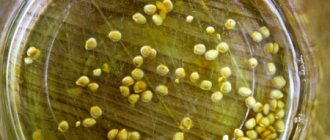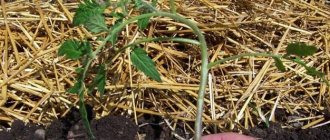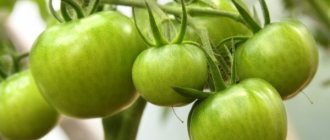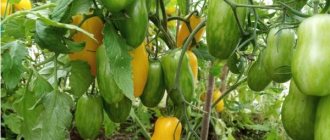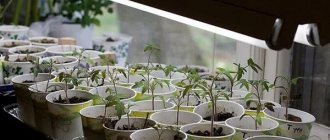Tomato hybrid Babushkina Pride f1 is widely used in cooking. Thanks to positive reviews, it can often be found in the gardens of avid gardeners.
| Height | Landing location | Ripening time | Fruit color | Fruit size | Origin | Fruit shape |
| Tall | Greenhouse, Open ground | Early ripening | Reds | Large | Hybrid | Round |
Care after transplant
After transplantation, the seedlings are left untouched for 10-12 days, giving them the opportunity to take root and adapt to new conditions. During this period, it is necessary to control the light intensity so that the sun does not burn the leaves.
Feeding
The first fertilizing with a manure solution is carried out as soon as rooting takes place and the first shoots appear. To prepare it, mix manure with water (1 bucket each), leave for a week, and dilute 1:10 before use. Consumption – 1 liter per hole. At the beginning of flowering, humates, simple and double superphosphate, and complex fertilizers (Universal, Kemira Lux, Senior Tomato) are used. When the ovaries appear, feed with magnesium sulfate.
Related article:
Recipes for feeding tomatoes growing in open ground
Good to know: Recipes for the best fertilizers for seedlings
Watering
It is recommended to water in the morning or evening, but evening watering is preferable - moisture remains in the ground longer. In the greenhouse, before flowering begins, water every 3-4 days, consumption - 2-3 liters per hole, when flowers appear - once every 7 days, consumption - 5 liters per plant, during the period of fruit formation - moderate watering every 4-5 days . As soon as the tomatoes begin to turn red, reduce the amount of watering.
On an open ridge, watering is carried out depending on the weather. If it is warm and there is no rain, then every two days up to 2 liters are poured under the young plant; in cool weather, water less frequently. As the plant grows, the consumption is increased to 3-5 liters, the frequency of watering is no more than twice a week. During the flowering period, the norm per hole is 5 liters, during the fruiting period - 1.5-2 liters.
If mulch is used, the mode and volume of watering should be reviewed, since moisture evaporates more slowly.
Stepping, bush formation
The Family tomato, as a representative of determinate varieties, has three stems formed in protected soil. To do this, do not remove the first two stepsons, shortening them after the formation of the first cluster of flowers. 1-2 stems are formed on an open ridge. If one stem is desired, then leave the top, removing all the stepsons; if there are two, then the first stepson is not touched, all subsequent ones are removed.
Pruning (removal of side shoots) is carried out every 10 days. The shoot is pinched or cut off, leaving a small stump - it is needed so that a new shoot does not begin to grow in this place again. At the same time, remove the lower leaves - 1-3 at a time.
Hilling, loosening, mulching
Until the tomatoes have grown much, the soil is loosened to a depth of 3 cm every two weeks. At the same time, weeds are removed. When they grow, the row spacing is loosened less frequently. To keep the soil loose and retain moisture longer, it is mulched with dry grass, chopped branches, straw, rotted compost, old sawdust (fresh sawdust increases acidity). A 6-8 cm layer of mulch allows air to pass through, retains light, interferes with grass growth, and reduces evaporation.
Related article:
Why do tomatoes have white streaks inside?
The first hilling is carried out 2-3 weeks after planting the seedlings. Raking soil towards the trunk creates conditions for the formation of additional roots. The next hilling is in two weeks. The soil near the stems gradually erodes, so they hill up several times a season.
Treatment against pests and diseases
Preventive spraying against possible infections is carried out every two weeks throughout the season. A good effect is achieved by using the plant-safe product Fitosporin. It is diluted in a ratio of 1:10 and sprayed on the bushes in the morning.
Prevention of damage by insect pests will be spraying with folk remedies: infusion of garlic, onion peels, tobacco, ash, solution of soda and iodine.
Growing rules
Even a beginner can grow tomatoes of this variety, as it is quite easy to care for. In greenhouse conditions, it can be grown throughout the country, but planting in open ground is possible only in the southern and central regions of the European part of Russia.
Planting seedlings
The step-by-step preparation of seedlings can be described as follows:
- Disinfect the seeds in a weak solution of manganese.
- In March, the seeds are sown in loose, heated soil, previously fertilized. To prevent fungal diseases, it is recommended to disinfect the soil again, this time. To do this, it is sprayed with a solution of copper sulfate.
- The distance between two adjacent seeds is 2-3 cm. They are sprinkled with earth and sprayed with water at room temperature.
- The container with the seeds is covered with film and placed in a dark room. Optimal room temperature: +25°C.
- With the appearance of the first leaves, the seedlings are placed on the windowsill and the protective film is removed.
- When at least 2 true leaves appear on each seedling, they are distributed into separate containers. This procedure is called picking, which allows the tomatoes to harden the root system.
- If there are 5-6 leaves, the tomatoes are moved to the beds.
This video provides additional information on preparing seeds for seedlings:
Tomato transplant
When moving seedlings to open ground or a greenhouse, it is recommended to follow a planting scheme in which the distance between neighboring bushes is at least 1 m. This is a very large-fruited variety, so thickening the beds can cause inhibition of the growth of tomatoes - they simply will not have enough light and nutrients. Thus, for 1 sq. m there are at most 3 bushes. If you form tomatoes not into 2 stems, but into 1, then you can increase the planting density to 4 pieces. per 1 sq. m.
Important! When planted in open ground, the Pride of Siberia tomato may be attacked by wireworms, so it should not be planted next to rows of potatoes.
Subsequent care for tomatoes
The variety is unpretentious, but responds well to watering and fertilizing. However, the bushes are not watered for the first two weeks, since young seedlings at this time are not able to fully absorb moisture. After this time, the tomatoes are watered frequently and abundantly. When watering, be sure to use warm, settled water - cold water can cause root rot.
It is better to water in the morning to minimize the risk of sunburn of the foliage.
The bushes are fed with phosphorus, potassium, as well as organic matter: bird droppings, manure, mullein. Potassium and phosphorus fertilizers are usually applied during the period of active plant growth.
Bush pruning is also required. The abundance of shoots will cause the fruits to become small and watery, so they are pinched, leaving 1-2. Finally, due to their large fruits, the bushes are tied up, otherwise the branches with tomatoes may break.
Characteristics and description of the variety
The description of the Babushkino variety should begin with the fact that this tomato is not a hybrid, and it does not have F1 hybrid forms that can grow without pollinators. Consequently, tomato bushes will need to be pollinated: with the help of insects or manually (when tomatoes grow in a closed greenhouse).
Detailed description of the Babushkino tomato variety:
- the plant is of the indeterminate type, that is, it does not have an end point of growth;
- bushes are not considered standard; their crown must be formed during development;
- The ripening time of tomatoes is mid-early - for full ripeness, a tomato needs from 3.5 to 4 months from the date of sowing the seeds;
- the height of the bushes often exceeds 220 cm, so they must be tied up;
- tomatoes can be grown both in open ground and in a greenhouse - it depends on the region and climate;
- the Babushkino tomato is considered very resistant to external factors: plants tolerate low temperatures well, feel normal in the heat, and rarely get sick;
- the fruits are formed in clusters, each of which can hold up to 12 tomatoes;
- the shape of the tomatoes is flat-round, slight ribbing may be observed;
- The color of a ripe tomato is raspberry-red, the flesh is a rich red hue;
- There are several chambers inside the tomato, very few seeds;
- the tomato pulp is fleshy, very juicy, sweet with a slight sourness;
- The taste of the variety is excellent, the tomato is suitable for any purpose;
- the weight of the fruit is quite large - from 300 to 800 grams;
- the yield of the bush is high, but only with sufficient nutrition;
- There are a lot of dry substances in the fruits, so they are stored well and for a long time.
Babushkino tomatoes can be used for absolutely any purpose. Purees and juices are prepared from the fruits, fresh salads are made, tomatoes are salted and pickled, whole or cut. This variety is also excellent for sale, because the tomatoes are stored for a long time, tolerate transportation well, and have a very presentable appearance.
Strengths and weaknesses of the variety
The Babushkino tomato variety was developed only 20 years ago, but its popularity is constantly growing. This is because tomatoes have several undeniable advantages:
- not afraid of return frosts;
- gives high yields;
- The fruits are large in size and have excellent taste;
- plants practically do not get sick, as they are immune to most “tomato” diseases.
Read also: Whole barberry (Berberis integerrima): description, photo
With all these advantages, the Babushkino tomato is very easy to grow, because it is unpretentious and does not need any special care.
However, the variety also has its disadvantages, which the gardener must be aware of:
- tomatoes are prone to cracking, so you need to be careful about watering and fertilizing;
- due to the small number of seeds in the fruits, the Babushkino variety is very difficult to propagate;
- often the tomato turns yellow around the stalk, this indicates a lack of potassium or magnesium in the soil.
Of course, all these nuances more than cover the quality, quantity and size of the fruit. Therefore, you should definitely plant at least a couple of Babushkino tomato bushes on your plot or in a greenhouse.
Description of the variety
Tomatoes of this variety are hybrids that are excellent for growing in open ground and in greenhouse conditions. “Grandmother’s Pride” brings harvest within three months from the time of sowing. In the southern regions, where the average annual air temperature in April is above 20 degrees with the greenhouse method of growing seedlings, you can get a harvest as early as the end of May. To do this, sowing seedlings must be done in early February.
Tomato “Grandma’s Pride” f1 has its own distinctive features:
- A plant planted in a garden bed rarely grows more than 0.7 meters; in greenhouse conditions, a tomato can reach 5 m.
- The amount of foliage cover is average. The leaves are small in size and bright green.
- The inflorescences of this plant are simple. 5-6 fruits are formed on the branches.
- The variety has high yield. With proper care, you can harvest up to 9 kg of harvest from one bush.
Features of cultivation
“Grandma’s Joy” tomatoes are sown in early March in pre-prepared containers with soil. Seeds are planted to a depth of no more than 2 cm. The distance between planted seeds should be at least 2 cm. To ensure better germination, the crops are watered and covered with film.
If there is poor lighting in the room where the seedlings are being germinated, lamps are installed above the container with the seedlings. In the southern regions, seeds can be sown directly in the garden bed and covered with plastic wrap overnight. After the plants get stronger, they are thinned out and planted.
After two or three leaves appear on the sprouted shoots, they need to be planted:
- This usually happens 50 days after sowing the seeds.
- Before planting plants in their permanent place, you need to prepare the soil.
- Before planting seedlings, the bed is dug up, then large clods of earth are broken and loosened with a rake.
- After this, the ground is fertilized with a mixture of ash, humus and burnt manure. For 1 sq. One bucket of this fertilizer is enough for a meter of soil.
- Immediately before planting seedlings, the ground is watered with a weak solution of manganese. This measure will help avoid infection of plants with diseases that, even in the early stages of growth, will negate the possibility of obtaining a good harvest.
- The gardener determines the distance between the beds himself. It should be such as to provide free access to each plant, but not less than 0.75 m. The distance between holes for bushes with one central stem should be about 60 cm. For plants with three to four stems, the distance between bushes should be about 70 cm.
Excess branches and foliage are removed as the bushes grow in order to ensure a better supply of nutrients to the ripening fruits. Water the tomatoes at least twice a week up to the roots. In regions with hot and dry climates, watering is carried out more often. The soil around the stem is loosened as needed. As they grow, the stems are tied up; plants of this type cannot be grown without support.
You can ensure a good tomato harvest if you know and use some tricks:
If plants grow in greenhouse conditions, on warm days you need to open the greenhouse doors slightly to ensure ventilation. This measure will help remove excess moisture from the greenhouse and protect the crop from rotting. On warm sunny days, ground tomatoes are completely freed from the film.
At night they are covered again. The bushes are watered to the very roots; this rule is especially important for regions with hot climates. In the southern regions of summer, watering is best done in the evening, after the heat has subsided.
To water the seedlings, use water at room temperature. Ice water is destructive for young shoots. Tomato feeding can be done with ready-made mixtures purchased in specialized stores or with infusion of chicken manure. In the spring, burnt manure and sand are added to the soil in the garden bed. Tomato bushes are fed approximately 1-2 times a month until fruit set. Weeds in the area are constantly removed, although some gardeners have the opinion that in arid regions it is possible to leave grass between the rows, they say, this measure helps protect the roots of the tomatoes from drying out.
Features of cultivation and storage
Tomatoes are grown in seedlings. Preparing seedlings for planting in open ground begins in the second decade of March. When grown in greenhouse conditions - at the end of February. First of all, you need to prepare the seeds:
- check for germination - immerse in water for 15-20 minutes and select the floating seeds for further cultivation. The rest are worth getting rid of;
- disinfect - place in a pink solution of potassium permanganate for 10-15 minutes;
- carry out hardening - place it in the refrigerator for 20 minutes a few days before planting, increasing the duration of stay in the cold environment every day.
Pre-hardening of seeds and sprouts allows you to get stronger plants. When carrying out this procedure, the seeds must be dry.
Agrotechnics of cultivation and care
In order to grow Grandma's Secret tomatoes in conditions with a changeable climate, it is advisable to equip greenhouses to ensure a suitable temperature of 25°C. If cultivation is practiced in open ground, then it is necessary to install arcs for film cover in case of cold weather.
The main method is seedling cultivation. For sowing, prepare a soil mixture of equal parts of sand, humus and turf soil. You can purchase ready-made soil with a balanced composition. To avoid picking, use peat or plastic cups that are filled with soil substrate.
The sowing of tomatoes of the Babushkin Secret variety begins in the first ten days of March. For disinfection, seeds are soaked for 45 minutes in a light pink solution of potassium permanganate. You can use growth stimulator Zircon or Epin according to the instructions. The processed seeds are laid out on a paper towel to remove excess moisture.
Moisten the soil in cups, make a hole in the center and place three seeds. If you decide to grow Grandma’s Secret tomato seedlings in a common seedling container, then make shallow (up to 20 mm) grooves, spray with warm water and lay out the seeds at intervals of 20 mm.
The containers are covered with a transparent film, ensuring greenhouse conditions. Seedlings grown in a common box dive when two true leaves develop
The soil is moistened and young shoots are carefully removed, transplanting them into local cups
If the seeds were planted immediately in separate pots, then check the number and condition of the seedlings. Weakened specimens are removed, leaving one strong seedling.
You should water the seedlings in a timely manner and apply mineral liquid fertilizers twice, aimed at young seedlings. When warm weather sets in by the end of April, young plants are taken out to the veranda or balcony for the purpose of hardening. Approximately 7 days before the planned planting in a permanent place, the plants are irrigated with the antifungal agent Fitosporin.
During this same period, they begin to prepare the greenhouse. A suitable soil mixture consists of turf soil, high peat, and sawdust in equal parts. The soil is dug up, having first added a bucket of humus per m2. Then the beds are arranged, taking into account that the row spacing should be 0.6 m. The distance between the holes is 0.5 m.
Before transplanting the seedlings in the first ten days of May, the soil is watered with potassium permanganate, preparing a weak pink solution. Pour a tablespoon of complex fertilizer into the hole. You should add a handful of sand if the soil is heavy loam.
Further care of the bushes consists of timely, abundant watering using settled warm water. Repeat it after 6 days. The resulting surface crust is loosened, while removing weeds. Plants also require fertilizing. It is recommended to apply the full mineral complex at least three times per season.
Considering that the Grandmother's Secret tomato is a tall crop, measures to form bushes should be carried out in a timely manner. Leave two strong stems, subsequently removing the emerging stepsons. If the greenhouse area is small, then bushes are formed into one stem.
When flowers appear, artificial pollination measures must be taken as there may not be enough bees in the greenhouse. On a sunny day, shake the flowers, then water the soil and spray the buds with a small amount of water from a spray bottle. After 6 hours, open the windows to reduce the humidity.
In open ground, the Babushkin Secret tomato variety produces a predictable yield in regions with a warm climate. The soil under the bushes is mulched to ensure moisture retention. Bushes are formed into two or three stems, if a distance of at least 0.6 m was initially left between them.
Be sure to install a support near each plant, to which the remaining stems are tied as they grow. At the end of August, the tops are pinched to provide the ripening tomatoes with a sufficient amount of nutrients.
Planting tomatoes
Seeds of the hybrid variety must be purchased annually from producers. Only 75% of seedlings from independently collected seeds inherit specific characteristics. It is better to sow the seed immediately into separate pots or cups. When sowing is carried out in common planting containers, plants are picked only after the appearance of 3 full-fledged leaves.
For a hybrid, it is important to choose the right soil with a low peat content. Seedlings develop well in distillation and special soil mixture for tomatoes
The sowing period depends on the region; on average, at home, seedlings grow in 50–60 days. The heat-loving tomatoes Pride of the Feast are planted in greenhouses after return frosts, in open ground, when the temperature at night does not drop below +10°C.
Growing seedlings
Seedlings grow well at temperatures up to +25°C. The tomato is resistant to root rot; nighttime temperature drops do not have a negative effect on the seedlings. During the first month, once a decade, it is recommended to add “Krepysh” or other balanced fertilizers for seedlings to the water for irrigation.
When the stems stretch strongly, lighting is required. An economical lamp is placed near the plants, which does not heat up during operation. Daylight hours are increased to 12 hours.
Planting in greenhouses and open ground
The seedlings are placed in two rows with an interval between the bushes of 60 to 80 cm. The tomato removed from the pot is carefully placed in holes up to 30 cm deep. It is enough to remove the reinforcing mesh from peat tablets
It is important to preserve the earthen ball as much as possible during transshipment so that the bush immediately begins to grow
The soil around is well compacted and watered. The bushes are mulched from above and the stem is tied to a support or trellis. Tomatoes are planted in open ground and under film covers a week later than in a greenhouse.
Origin and characteristics of the variety
The authors of the variety are Novosibirsk breeders T.N. Postnikova and V.N. Dederko, known for their work on breeding tomatoes characterized by high yields and excellent consumer qualities. Most trading enterprises sell tomato seeds of this variety produced agro.
The variety is a typical large-fruited salad tomato. Plants develop according to the indeterminate type, that is, they gain green mass throughout the entire growing season, while simultaneously forming ovaries and forming a crop. In protected ground, bushes can reach a height of 150-200 cm; in beds their height usually does not exceed 100 cm.
The ripening period of tomatoes is about 110 days from the moment of full germination. The photo of the “Grandma’s Secret” tomatoes is impressive: the ripe fruits are large, pink, and have a flat-round shape with distinct ribbing. On average, their weight is about 350 g. According to vegetable growers, tomatoes weighing up to 700 g or more can ripen on the lower clusters.
The pulp is dense, sugary when cut, with an excellent taste and a specific “tomato” aroma. According to the official description, the fruits are intended primarily for fresh consumption, but the quality of the juice prepared from them is also rated very highly. The variety is considered productive: with proper care and comfortable weather conditions, up to 3 kg of tomatoes can be harvested from each bush.
Growing Grandma's Secret tomatoes requires agrotechnical techniques typical for cultivating indeterminate varieties of tomatoes. Seedlings are planted in a permanent place at the age of 55-60 days (more “mature” seedlings “stretch out” and take root poorly), placing 3-4 plants per square meter. The bushes are formed into 1-2 stems, pinching the main trunks after the formation of 3-4, and the “stepchildren” – 2-3 flower clusters in order to avoid the accumulation of excess green mass and chopping of fruits.
If the stems of the seedlings are thin and the leaves are quite large, it means that the seedlings have “stretched out”. In this case, it is planted by deepening a significant part of the trunk along with the lower leaves. The longest bushes are planted in grooves, placing the stems at an angle or lying down. This is not harmful to the plant, on the contrary: over time, additional roots form on the buried part of the trunk, which increases the activity of nutrient absorption. The process of ovary formation is slightly delayed. In addition, overgrown bushes are easily injured, which is very inconvenient for gardeners who are forced to grow seedlings in city apartments and transport them to plots.
The variety “Grandma’s Secret” has a number of features that must be taken into account:
plants must be tied to supports (preferably, each stem separately); Tomato does not have increased resistance to late blight, nor is it precocious, allowing the harvest to be harvested before the onset of the disease. Therefore, during the season it is necessary to remove all leaves located below the ovaries to reduce the likelihood of plants being damaged by pathogenic fungi
It is equally important to regularly treat the bushes and soil with appropriate protective agents; the taste and consistency of the fruit strongly depends on the cultivation conditions (number of sunny days, watering regime, soil composition, etc.); Ripe tomatoes do not tolerate transportation well and cannot be stored for a long time.
Productivity
The hybrid tomato Babushkina Pride is characterized by high yield. If you follow the basic rules of agricultural technology and crop rotation, you can harvest up to 9 kg of delicious tomatoes from one bush. The fruits are round in shape, slightly flattened, with a small nose. Weight reaches 250 grams. Tomatoes are sweet, aromatic, meaty. There are 4-6 seed chambers.
The hybrid is recommended for fresh consumption. It makes excellent salads and appetizers. Suitable for whole fruit canning. Thanks to its fleshy pulp, you can prepare delicious tomato paste, adjika, and ketchup. The fruits can be salted and pickled.
Rules for caring for Babushkino tomatoes
Many gardeners consider the variety to be unpretentious, but everyone has a definite opinion. In general, it is impossible to do without care, but there are no serious difficulties in growing it.
- Timely watering is essential for any tomato variety. This one is no exception. Watering is not frequent, but plentiful.
- The earth should not be crusted over. If this happens, it is loosened with a squeegee or similar garden tool.
- Removing weeds is necessary so that plants get sick less and get maximum benefit from fertilizing, watering, and loosening the soil.
- The Babushkino tomato is grown on a trellis or high support, since the variety is indeterminate. As the bushes grow, you need to make sure that they cling to the support, without bending to the side. If necessary, tie up the bush.
- If large fruits ripen on the branches, it is advisable to tie them to a support so that the tomatoes do not fall when ripe.
- The plant must be properly shaped in order for it to produce enough yield. Bushes are formed into 2 and 3 stems.
- The plant reacts sharply to a lack of nutrients, so fertilizing must be applied in a timely manner. Fertilizers are applied organic and mineral. In this case, you need to alternate them.
Important! Tomato Babushkino needs regular feeding
This issue needs to be given special attention!
Tomato Babushkino
Description and characteristics of the tomato variety Babushkino, reviews, photos
The most productive variety I have ever grown. The bush is tall, about 1.8 meters. I grew it in 2 and 3 stems, the yield pleased me in both cases.
The variety is indeterminate, large-fruited. The weight of individual tomatoes reached 600 g, and on average about 300-400 g. The brushes are large, heavy, they must be tied up, otherwise they will break off.
Tomatoes are red, flat-round. The taste is tomato, sweet, slightly sour.
Disadvantage : prone to cracking.
The tomato is well suited for salads and making juices and purees.
I will definitely grow it next year, only from my own seeds.
In some catalogs this tomato is called Babushkin .
In 2021, this variety was included in the State Register of the Russian Federation for cultivation in greenhouses and under film covers on private farms.
Babushkino tomatoes on video
The variety is very productive; additional feeding is required.
This variety is not listed in the State Register of Breeding Achievements of the Russian Federation. Since this tomato is an amateur selection, you can purchase its seeds from collectors. Agricultural companies do not deal with this variety.
If you grew Babushkino tomatoes, please write whether you liked them or not. What was the yield and taste of the fruit under your conditions? How do you rate the disease resistance of this variety? If possible, attach a photo of the entire bush or individual fruits you grew to your comment. Thank you!
Description of the Dorodny tomato variety, growing characteristics and yield
Tomato Dorodniy is produced agro and is intended for dietary and baby food. It is grown throughout the Russian Federation and in neighboring countries. Why this variety is so good and how to grow it, we will consider below.
Characteristics
The variety is of indeterminate type, early ripening - 110–115 days pass from seed germination to the receipt of the first ripe tomatoes. Fruits better in closed greenhouses. Characteristics of the bush: tall. When grown indoors, it reaches a height of 2 meters. The bush is powerful, the leaves are large. When growing, plants require staking and pinching.
The fruits are large in size - the weight of one is from 300 to 600 grams, some fruits reach sizes of 800 grams, and are raspberry in color. The surface of the fruit is ribbed on large fruits and slightly ribbed on smaller fruits. The taste is sweet and bright. When cut, it has 8 nests with seeds. When ripe, the stalk does not have a green spot. The pulp is fleshy and juicy.
The fruits can be used to make tomato juices, sauces, and canned salads. The fruits are tasty fresh - housewives often prepare summer salads from them.
Agrotechnics of cultivation
The variety is grown mainly in seedlings by planting plants in an indoor greenhouse. Description of cultivation:
- Seeds for seedlings are planted in mid-March in fertile soil.
- The plantings are covered with film until the first shoots appear.
- Then the film is removed and cultivation continues until two true leaves appear on the bushes.
- Afterwards, the seedlings are planted into separate containers. So it grows for another two weeks in a sunny place indoors.
- After this period, the land is fertilized for the first time.
Plants should be transplanted into the greenhouse at the age of 60–65 days. Then 6–7 true leaves are formed on the bush. After transplanting to a permanent place of growth, the tomatoes are fertilized three more times, and the bushes are also cared for. It consists of the following manipulations:
- Weeding.
- Watering and loosening the soil.
- Garter and stepson.
- Treatment with poisons against diseases and pests.
In order for the fruits to ripen together, you need to trim the lower leaves. Then all the nutrients will go into the growth of vegetables, not the bush. Plants are fed: during flowering, formation of ovaries, ripening of tomatoes.
Plants of the Dorodny variety respond well to fertilizing and frequent watering, but this should not be abused. If the soil is too wet, the root system may rot and the plants will die. Fungus also develops well in climates that are too humid. Therefore, all manipulations must be carried out in moderation.
Harvesting is carried out as the fruits ripen. If ripe tomatoes hang on the branches, then the plant will not have enough energy to ripen green vegetables.
Weeding and loosening the soil will help get rid of grass, which absorbs nutrients, and fungus, which actively develops in airless soil.
Review of reviews about the variety
Gardeners leave positive reviews about the taste and varietal characteristics of the variety:
- Early ripeness.
- High yield.
- Excellent taste.
- Many people like the size of tomatoes.
- Duration of storage.
- Disease resistance.
Here is a small number of positive qualities of the Dorodny tomato, which were noted in reviews by summer residents and gardeners of the country. With proper cultivation and constant care, tomatoes will delight you with their size and taste.
Characteristics of the variety
The fruits ripen quite early; already on the 85th day from the moment the seeds are planted, you can get the first ripened tomatoes. The color of unripe fruits is light green, while ripe fruits are bright red. The tomato is round in shape, slightly flattened on top, and the fruit has a small tubercle at the bottom. One tomato can gain weight up to 250 grams.
The pulp is dense, very juicy. Tomato "Granny's Pride" has a good taste and characteristic aroma.
The fruits are intended to be consumed raw, but can be used for cooking:
- juices;
- adjika;
- pastes;
- lecho.
Tomatoes can be harvested as one of the ingredients when preserving winter salads.
“Grandma’s Pride”, a tomato that is included in the Russian state register, is intended for growing an early vegetable in unheated greenhouses with a film coating. "Granny's Pride" is an early ripening variety. Tomatoes of this variety are intended to be eaten raw.
Tomato "Granny's Pride" is resistant to brown spot.
